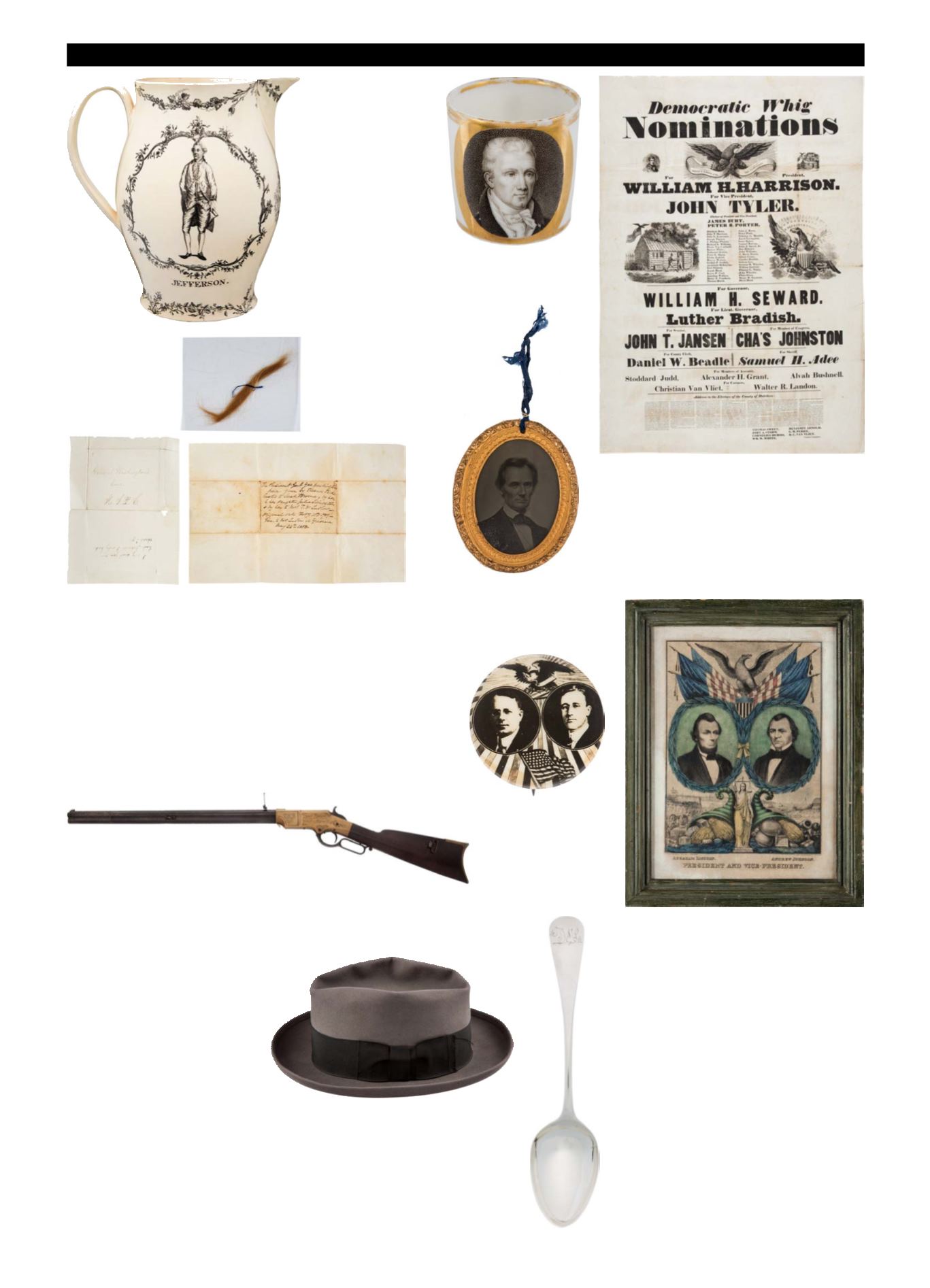

8-C Maine Antique Digest, April 2017
-
AUCTION -
8-C
To best understand the importance of this lever-action
Henry rifle that also has a connection to Contention, Arizona Territory,
the catalog entry put together by Heritage is a must-read. This rifle, which
sold for $21,000 (est. $24,000/36,000), is considered by many to be the precursor
to the legendary Winchester rifle. The New Haven Arms Company manufactured 14,000
of these before 1866. Of that total, 1731 were purchased by the United States Army, and
about 90 were shipped to Fort Knox in Maine. This example bears a stamp of “57” on the
underside of the receiver, as well as “Fort Knox, Maine” in block lettering.
Said by Heritage
Auctions to be one of
the largest presidential
Liverpool pitchers it has
come across, this 11"
high Thomas Jefferson
creamware pitcher
decorated with a standing
Jefferson image on one
side and a color image of a
packet with an American
flag on the other sold for
$12,500 (est. $8000/12,000).
This Paris porcelain demitasse cup
with a stipple-engraved transfer
portrait of James Monroe sold for
$10,625 (est. $9600/14,400).
A favorite remembrance of a loved one was securing a lock of his or her hair.
This hefty lock (3½" long) of George Washington’s light reddish-brown hair
held together with blue thread sold for $32,500 (est. $16,000/24,000). It came
with three pieces of period documentation:
A 2¼" x 2" folded packet inscribed on the front with “General
Washington’s / hair. / H.F.P.C.” (Harriet Frances Putnam Carnochan [1859-
1905], a great-granddaughter of Declaration of Independence signer Lewis
Morris), and on the reverse with “I only send you one / hair because I only
had / three. F.”
A 2½" x 1
⅝
" folded packet inscribed “The President Genl. Geo.
Washington’s / hair given by Eleanor Parke / Custis to Sarah Broome; by her
/ daughter Julia Livingston / and by her to Mrs. T. W. Ludlow— / Original
date Feby. 10th 1789— / Given to Mrs. Ludlow at Grasmere / May 24th
1853.”
A 2½" x 4¾" envelope (not shown) with similar inscriptions but dated
January 1875.
A piece from the iconic Merrill C. Berman collection
made its way into this December Heritage Auctions
event. One of the final pieces that he chose to sell was
this impressive 1840 campaign poster for William
Henry Harrison. Great graphics, including a portrait of
Harrison, two log cabins, and two eagles, great size (33"
x 23"), and the great condition helped this beauty sell for
$32,500 (est. $24,000/36,000).
This 15" x 10¼" (sight size) Lincoln and Johnson 1864
jugate print by E.B. & E.C. Kellogg sold for $15,000
(est. $9600/14,400). There are two versions of this, one
done by Currier Grand National Banners and this
one, a framed Kellogg example.
This Abraham Lincoln 1860
campaign ambrotype sold for $20,000
(est. $16,000/24,000). According
to Heritage Auctions, it is “almost
certainly the first 1860 photographic
campaign item.”
Found hidden inside a lesser
jugate campaign button,
this Cox and Roosevelt St.
Louis Button Company
jugate sold for $17,500 (est.
$16,000/24,000).
With a 3" long oval bowl and made up of slightly
more than two ounces of silver, this tablespoon made
by Paul Revere, 1790-1800, sold for $12,500 (est.
$12,000/18,000). The handle is engraved “DMS,”
the initials representing Daniel Sargent (1731-1806)
and Mary Turner Sargent (1743-1813), a prominent
couple who lived in Boston in the 1770s.
Heritage’s catalog entry states, “Daniel
Sargent was a successful merchant, and Mary
Turner Sargent was born in a house built by
her grandfather that later was made famous by
Nathaniel Hawthorne’s novel [
The
]
House of the
Seven Gables
. She was also the subject of a 1763
painting by John Singleton Copley, who is perhaps
best known for his later portrait of Paul Revere.”
This gray felt hat owned by Thomas Edison
sold for $10,937.50. It came with a wonderful
back story, as described by Heritage
Auctions.
“On January 11, 1929, Edison was in his
East Orange, New Jersey, laboratory along
with longtime friend and business associate
Edward Adams. Adams’ daughter tells the story of the
hat in a letter to Edison's daughter:
“‘
After a long serious conference, my father joked about who had the biggest head and
suggested that they exchange hats, to which Mr. Edison agreed. They found to their delight that
the hats fit each other perfectly, and my father said, “Thank you, I am going to keep your hat,”
and he walked out the door.
’
“In another letter to Edison’s daughter:
“‘
Among the many household treasures that were moved into my home after Mr. Adams’
death was a “KNOX” hat box with a gray felt hat in it and a card explaining that this hat
belonged to Thomas Edison
.’”
That card was sold with the hat, as were photos of Edison wearing this same hat.











